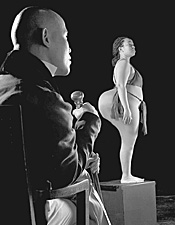The Guardian recently had two fascinating articles in the context of race in their history section. First last week's 'Flesh made fantasy' by Rachel Holmes, about an early 19th century African showgirl in England, then yesterday's 'The fascist who 'passed' for white' by Gary Younge, on an influencial early 20th century American fascist and his secret mixed-race origins.
After a bit of further research and some writing I found myself confronted with an explosion of interesting side-topics, so for now I'll refrain from commenting on the latter. But both articles are recommended reading material.
Buttocks, Bums, Arses, Posteriors, Rumps
In Flesh made fantasy we're told the story of Saartjie Baartman, an orphaned African farm girl who emigrated to London in 1810 at the age of 21, lured by a white man's promise of wealth and a better life. She ended up spending her days as a showgirl and sideshow attraction (I understand the show mostly consisted of presenting her well-formed body in varying costumes) and died only five years later in Paris, possibly of smallpox.
Today she is most well-known in the first world as an iconographic cornerstone of exotism and sexuality, the latter attributable to her splendid posterior which apparently triggered all kinds of white man's fantasies in England's colonial society...
From the Guardian article:
Saartjie was not only the African woman most frequently represented in racially marked British and French visual culture, she also had less immediately visible influences on western art. [...] Saartjie's body cast was one of the inspirations for Matisse's revolutionary restructuring of the female body in The Blue Nude (1907), prompted by African sculpture and conceived, as Hugh Honour argues, "as an 'African' Venus [...]"
It's a fascinating clash of tales of imperial exploitation and appropriation, the creation of a modern Venus image, and the sexual fantasies of a 19th-century society. And according to John R. Moore's The Afrikan Fashion Legacy Baartman's body might be a possible origin for the Bustle, that Victorian dress with exaggerated posterior.
My favorite section in the Guardian article:
Bottoms were big in late-Georgian England. From low to high culture, Britain was a nation obsessed by buttocks, bums, arses, posteriors, rumps - and with every metaphor, joke or pun that could be squeezed from this fundamental distraction. Georgian England both celebrated and deplored excess, grossness, bawdiness and the uncontainable.
If you enjoy the Guardian piece you might be interested in a great 2002 article by Gail Smith, 'Fetching Saartjie', on "the historic mission to return the remains of Saartjie Baartman to South Africa", which also explores the curious fact that French scientists chose to preserve her body for future research by not only making a full body cast, but also preserving her brain and genitals -- they where especially fascinated by her elongated labia.
Links
Related Reading
For a completely unrelated reason I was browsing old code project directories and found a copy of Stringulator, a throwaway weekend quickie from mid 2002. Turns out it runs on OS X, and it's relatively smooth. The best part though: when you turn on motion blur a relatively minor rendering bug gets triggered somewhere that makes the graphics look much cooler that ever intended... Now I wonder: did it also have a working fullscreen mode?
RewriteCond %{HTTP_REFERER} !^$
RewriteCond %{HTTP_REFERER} !^http://(www\.)?dekstop\.de [NC]
# old rule
#RewriteRule \.(gif|jpg)$ - [NC,F]
# new rule
RewriteRule \.(gif|jpg)$ http://www.hai2u.com/HotBlowjob.jpg [NC,R]
Cheap laptop mic -> AU Lab -> lots of amplification, some EQ, compression -> MP3. I love this lofi stuff. 128kbps versions streamable on Last.fm, but you really want to download the 160kbps version linked below.
I should fetch my mixer from Berlin, a little additional audio equipment opens up a much wider range of expressions. You can do so much with so little.
Since there are so many announcements about OpenID these days I decided it's time to actually have a look at the OpenID 1.1 spec. Turns out it's a light and fairly quick read, and its authors paid delightful attention to some crucial details.
I especially liked this:
The main advantage of [OpenID's delegation mechanism] is that an End User can keep their Identifier over many years, even as services come and go; they'll just keep changing who they delegate to.
And was impressed to see stuff like this in the spec:
It is RECOMMENDED that the form field [for the User's OpenID URL] be named "openid_url" so User-Agent's will auto-complete the End User's Identifier URL in the same way the eCommerce world tends to use conventions like "address1" and "address2".
Recycling Finally Makes Sense
I guess I won't start using the same OpenID account for all my identification needs, even if it might sound convenient. The thought of having a single login for everything isn't very appealing -- because it easily allows tracking you across services (cf the ubiquitous session cookie).
Here's what's so cool about this: OpenID allows you to reach a middle ground where you can have a limited number of accounts for most of your Internet interactions, regardless of the number of services you actually make use of; and each account can become an island, for use within a certain context. Your blogging account. Your throwaway test account. Your Digg and Slashdot trolling account. Your porn account.
That's the one feature that makes OpenID interesting to me: As soon as a significant number of websites start acting as OpenID consumers (i.e., they let you login via an OpenID account you registered elsewhere) you gain control over the number of passwords you have to remember. No more bugmenot, or relying on your browser or KeyChain to remember passwords for you. You'll be able to memorize them all.
Essentially, OpenID caters to our convenience while keeping us in control of our own privacy.
And all with a very simple mechanism -- with a little discipline it should be possible to write, test and deploy a primitive OpenID provider in a couple of hours. So if you don't want to trust anyone with your passwords and browsing habits it's dead easy to roll your own identification service from scratch, or deploy an open source implementation. And by the looks of things you're soon going to live in a world where your custom ID provider will work with all sites you care about.
Is there anything Brad Fitzpatrick can't do?
Just saw this at a bookstore. Flicked through it, looks great, doesn't seem like a fluff piece. Lots of mathematical symbols everywhere, transformation methods etc. Will buy lots of stuff like this when I'm rich.
Update Look what I found: Privacy Preserving Data Mining Bibliography, a categorized collection of papers. The table of contents provides you with a brief overview of the research field.
Judging from the title, the paper you (and I) will want to check out is State-of-the-art in Privacy Preserving Data Mining by V. S. Verykios, E. Bertino, I. N. Fovino, L. P. Provenza, Y. Saygin, Y. Theodoridis (2004).
Update2 del.icio.us tag: ppdm.
A simple visualisation of a user's music listening habits over time, derived from their weekly Last.fm artist charts. Safari/Firefox only.
The visualization concept is based on the gorgeous work Listening History by Lee Byron.
See also part one: Chart Arcs.
Was browsing the Mozilla developer docs, curious about their documentation on JavaScript language updates over the different Firefox versions (JS is getting more and more Ruby-like). Realized that I need to brush up on my JS knowledge, maybe finally time to get that O'Reilly book.
Found an "Introduction to the JavaScript shell" (they have a JS shell?!?), and this:
cvs -d :pserver:anonymous@cvs-mirror.mozilla.org:/cvsroot login
cvs -d :pserver:anonymous@cvs-mirror.mozilla.org:/cvsroot co -l \
mozilla/js/src mozilla/js/src/config mozilla/js/src/editline mozilla/js/src/fdlibm
cd mozilla/js/src
make -f Makefile.ref
Compiled it, ran it. print works. Cool!
Now I just need to figure out what to do with it.













